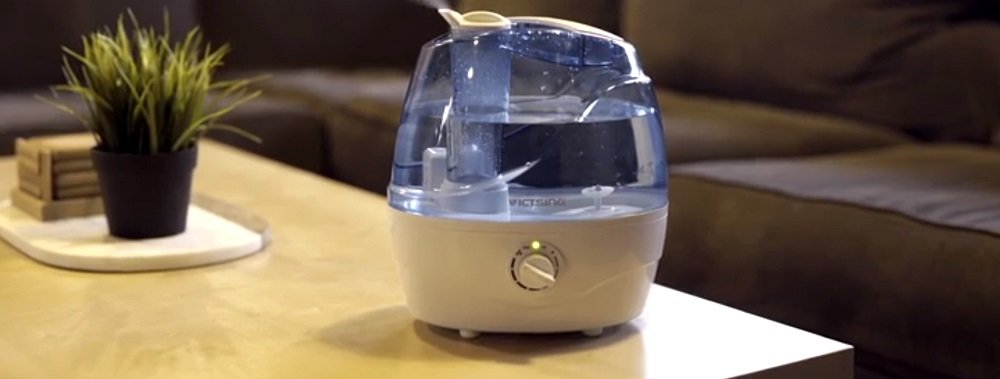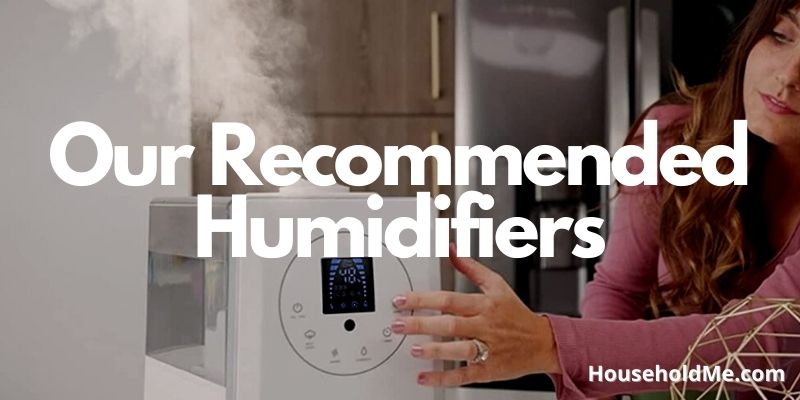The basic concept behind a humidifier is simple to understand, but the process of choosing one isn’t as easy to do. There are portable units and whole-home humidifiers. Some use evaporative technology while others rely on ultrasonic or straight-mist mechanisms.

Once you decide on the type of humidifier, you need to size the appliance for the space where you intend to use it. Although the square footage of the area is the main aspect you need to consider, you must factor in the area’s volume, load and other aspects.
To help you size a humidifier, we’ll tell you the factors you should consider, including square footage. We’ll also describe the main type of humidification technologies and the style that’s suited for areas of every size, so you can get the highest efficiency possible from the humidifier you buy.
Calculation Consideration 1: Square Feet
Most humidifier manufacturers list the intended room size for each model, and for a good reason as the square feet in the space is the most important factor.
Alongside that figure, manufacturers state the amount of moisture the humidifier typically adds to the air in a 24-hour period, which is known as the moisture output.
The moisture output rate is more or less accurate if the humidifier is used within the square feet listed in the specs. If you’re in doubt as to whether the humidifier will work for the room’s size, go for a bigger model.
For instance, if the specs say a humidifier is for a small room up to 400 square feet and the room is 360 square feet, go for a medium-size model.

Humidifier Output
| Area | Humidifier Output Rating |
| 500 sq ft or smaller | 1.5 – 2.0 gallons per day |
| 530 – 600 sq ft | 2.2 – 2.5 gallons per day |
| 700 – 800 sq ft | 3 – 3.5 gallons per day |
| 900 – 1000 sq ft | 4 – 5.0 gallons per day |
| 1000 – 2000 sq ft | 7 – 9.0 gallons per day |
| Over 2000 sq ft | 10 gallons per day or higher |
Calculation Consideration 2: Room Insulation
Room insulation, or tightness, should be considered after you measure the square feet. Since humidifiers circulate the air in a room X number of times per hour, the amount of air that flows in the room determines if you need to size up with your humidifier choice.
Homes or rooms that are overall airtight will have insulation in the walls and draft-free exterior doors and windows. The opposite is true for homes that are drafty. If you’re zone humidifying in a room that contains a fireplace, make sure the damper is closed.
Calculation Consideration 3: Room Volume
If you have ever Googled humidifier-size charts, you may have noticed they all provide about the same numbers. The major flaw with these general charts is that they are made with standard ceiling heights in mind.
In the past 25 years, that height has been 9 feet. Before then, the standard ceiling height was 8 feet.
Of course, every house is different. If your home has higher-than-average ceilings, you will under-size your humidifier if you purchase one strictly based on the chart. Again, the presence of high ceilings or vaulted ceilings means you should size up your humidifier.

Calculation Consideration 4: Humidification Load
The term humidification load describes the amount of moisture that should be added to the air to achieve a healthy level of relative humidity. The consensus in the scientific community is that a healthy indoor RH level ranges from 40 to 60 percent.
Drafts and temperature play a role in a room’s humidity level. Two other RH load factors are the number of people in a home, and the everyday activities in which household members engage. The more people inside of a home, the higher the RH because there will be more humidity-rising activities taking place, like showering and cooking.
Calculation Consideration 5: Gallons Per Day
Gallons per day refers to the moisture output rate we briefly touched on in the Calculation Consideration 1 section. When it comes to the GPD, the rate varies widely from one humidifier to the next.
Manufacturers determine the GPD through one of two ways. With steam-type humidifiers, the GPD is calculated by the amount of water that evaporates into the air. With other types of humidifiers, the GPD is calculated by how much moisture passes through the humidifier’s media, such as a wick.
Portable Humidifiers vs. Whole-House Humidifiers
Humidifiers fall into either the portable or whole-house category. As the name suggests, portable humidifiers can be moved from room to room, providing zone humidification to a single space.
Small ones are made to sit on tables or counters while larger ones are fashioned like a tower or rest upon caster wheels.
Whole-home humidifiers are somewhat self-explanatory – They are designed to humidify an entire house. Like portable units, whole-home humidifiers come in two sub-categories. Stand-alone humidifiers are stationary humidifiers that provide 24-hour humidification via a sink connection. Furnace humidifiers are installed on a furnace, and they have a dedicated water line.
Related Post: Best Whole House Humidifiers

Type 1: Cool-Mist or Impeller Humidifiers
Cool-mist, or impeller, humidifiers are equipped with a reservoir and a spinning disc. As the disc spins, it breaks up the water particles, turning them into a fine mist. Many people like impeller humidifiers because of their quiet sound output.
There is also no filter, which means no replacements to buy in the future. However, the lack of filter necessitates the used of purified or distilled water.
Related: Best Cool-Mist Humidifiers
Type 2: Warm-Mist or Steam Humidifiers
Inside of a war-mist, or steam, humidifier, there is a heating element. The heating element raises the temperature of the tank’s water to a boiling point. Once the water boils, the humidifier releases warm steam into the air. Steam humidifiers are also quiet.
Since the water and steam get hot, warm-mist humidifiers aren’t usually the first choice for households with curious pets or small children.
Related: Best Warm-Mist Humidifiers
Type 3: Evaporative Humidifiers
Instead of a spinning disc or a heating element, evaporative humidifiers contain a filtering wick. Highly absorbent, the wick soaks up the water in the reservoir. Then, the humidifier’s fan blows across the filter, blowing moisturizing mist into the room.
One of the benefits of using an evaporative humidifier is that the wick traps contaminants, allowing for the safe use of tap water. The downside is that the wick must be replaced every few months.
Related: Best Evaporative Humidifiers
Type 4: Ultrasonic Humidifiers
Out of all four humidifier types, ultrasonic humidifiers are the quietest – no fan and no steam-related noises. These humidifiers have two ceramic (or sometimes metal) plates that vibrate at a high frequency to bust up the water into ultra-small droplets.
The almost-silent operation is the ultrasonic humidifier’s appeal. However, they tend to create white mineral dust unless you add a demineralization cartridge to the tank.
Related: Best Ultrasonic Humidifiers

Humidifier by Room Size
If your house is relatively airtight, and the ceilings are 8 or 9 feet high, you don’t have to worry about making complex calculations based on volume and other factors. You can probably get away with following a rough guideline that takes into account the room’s or the home’s square feet.
Small Rooms
Unless the manufacturer specifies otherwise, small rooms (for humidifier sizing purposes) are rooms that measure fewer than 400 square feet, like bathrooms or small kitchens. For small rooms, compact and tabletop humidifiers are ideal.
These humidifiers produce up to 1.5 and 4 gallons of moisture, respectively. They don’t take up much space. They’re lightweight, and many of them have permanently affixed reservoirs.
Medium-Size Rooms
Medium-size rooms range from 400 to 1,000 square feet. Rooms of this size are usually bedrooms, large kitchens or small dens. Tower-style humidifiers that are made to sit on the floor are well-suited for rooms that fall into this square-footage range.
The majority of tower humidifiers put out anywhere from 2 to 4 gallons per day of moisture. Their tanks are typically removable, and they are also larger than that of compact and tabletop humidifiers, meaning easier and fewer refills.
Large Rooms
When a manufacturer stamps “for large rooms” on a humidifier’s package, it means the unit works effectively in rooms bigger than 1,000 square feet, such as large living rooms. As you know, tower humidifiers usually produce 2 to 4 gallons per day of moisture. Tower humidifiers that have a moisture rate at the upper end of this range are appropriate for use in large rooms.
Alternatively, there are small console humidifiers. Console humidifiers boast a larger output rate that is approximately double that of tower-style humidifiers.
Although they are heavy, console units are movable, and they have casters on the bottom for this purpose. Due to their output rate of 6 to 8 GPD, it’s possible to use them for dual-room or open-room humidification.

Related Articles
• What Size Essential Oil Diffuser Do I Need?
• What Size Dehumidifier Do I Need to Buy?
• What Size Air Purifier Do I Need to Buy?
Entire Homes
There are no portable humidifiers that can add moisture throughout an entire house. If this is your goal, you’ll need a whole-home humidifier. There are large console humidifiers that are capable of releasing as many as 9 gallons per day of moisture. If you live in a small house or apartment of up to 2,500 square feet, you may be able to humidify your entire place with a large console unit.
If your house measures from 2,500 to 4,000 square feet, you’ll need an in-duct or a furnace humidifier. In-duct humidifiers are specifically designed for whole-home humidification.
They are installed in a home’s existing central HVAC system, so they can deliver moisture into every room at the same time.

If you have any questions or comments, please add them below in the comment section. Similarly, please let us know if you spot any mistakes or omissions. Thanks!
Sources
HouseholdMe: Best Humidifiers in 2023
Lasko: Best Humidifiers for Asthma
Sylvane: Best Humidifiers for Dry Skin
TheOzoneHole: Best Levoit Humidifiers

Very informative article, well explained about the different humidifiers. It helped me to choose the one I need for my house